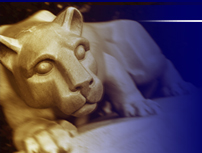Encounters: Native American and Western Religious Traditions Meet
Why have not beasts a soul as man hath, seeing they have love, anger, &c. as man hath?
Native American question to Christian missionary, John Eliot, 1648I have no acquaintances there, and the French who are there would not care to give me anything to eat . . .
Native American reason for not wanting to spend eternity in the Christian Heaven
Imagine what it would be like to walk through central Pennsylvania in 1600. There would be no roads, no buildings, no street signs marking the way. You would not encounter spacious farmlands, sliced into garden squares, or town boundaries. As far as your eyes could see would be dense forests, etched with barely perceptible trails and paths. Occasional meadows might be planted with corn and other vegetables, while streams and rock formations might serve as landmarks.
For the American Indians, this landscape was invested with meaning and familiarity. Through the centuries, they had devised meaningful ways of working and living within this landscape. For them, the forest was a hospitable environment, filled with abundant sources of the food and shelter that they needed to survive, as well as with spiritual significance. They believed that the birds, the animals, even the blades of grass were embodiments of great spirits. Each component of nature, from the sun to the wind, was represented by a god, who governed their functions and helped these forces to work with the people and other creatures who lived among them. Human beings were simply one part of this unified, spiritual continuum.
For the European explorers, however, the land seemed "uncivilized" and "undeveloped." Coming from a homeland of clear roadways, bustling towns, and farming estates, the vast forests and meadows must have been daunting, overwhelming, disorienting, awe-inspiring, and terrifying. At the same time, Europeans, arriving from cultures with market economies, would have been sure to notice the economic potential of the trees and animals growing in the forests. They could take lots of products from the land and sell them at home for profits.
The religious approaches of the various people who met in America during the 1600s shaped the way that they understood the nature around them. For the Indians, spiritual beliefs infused all of their daily activities and the entire way that they approached nature. For the Christian Europeans, religion was a prime reason why they made the dangerous trip to the American wilderness in the first place. French Catholic missionaries longed to convert the Indians to Catholicism, while English Puritans hoped to build a new society in accordance with God's plans and visions.
In this lesson we will focus on the way that their different religions shaped the European and Native Americans' engagement with nature and with each other, particularly in Southern New England. In my commentary, I will outline the main features of Indian religion, showing how it shaped their approaches towards nature, their ways of life, and their cultures. I will also review the general principles of Christianity (Catholicism and Protestantism), and show how the Europeans' religions shaped their perceptions of nature in the "New World." As the above quotations illustrate, the world-views of the natives and the explorers were often so different from each other that they had difficulty understanding the logic behind each other's belief systems. Their strikingly disparate religious systems and ways of life made the encounters between Indians and Europeans a dramatic confrontation of cultures.